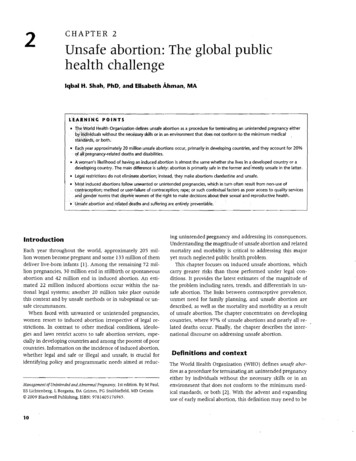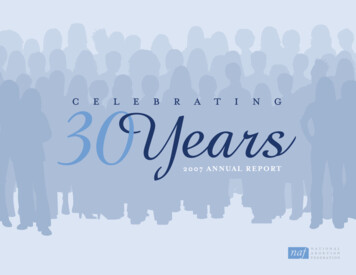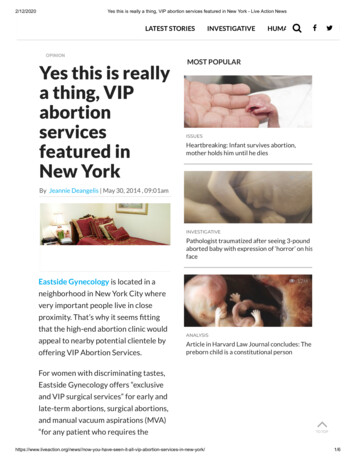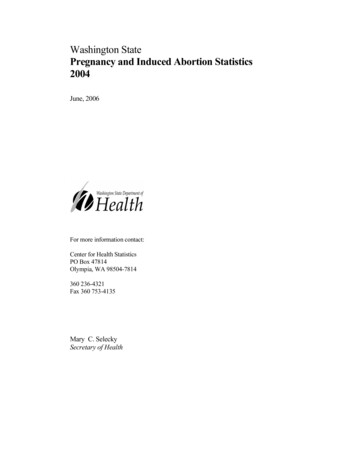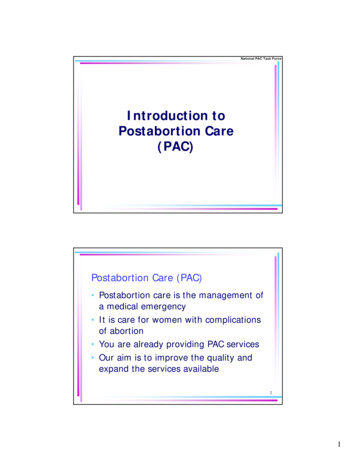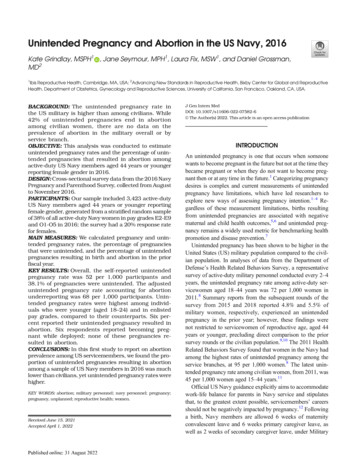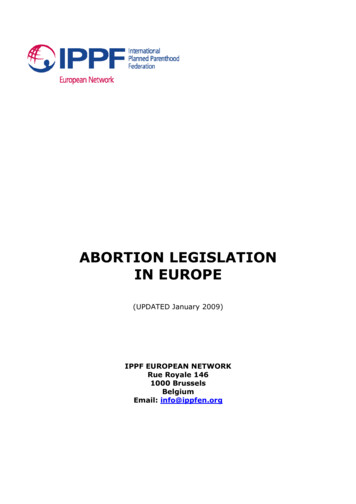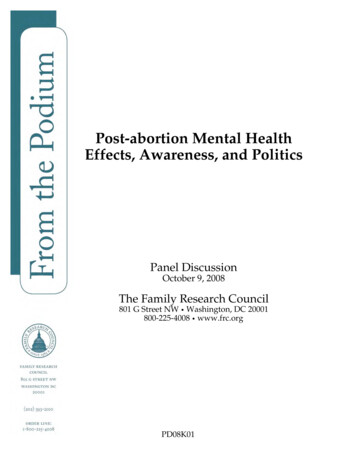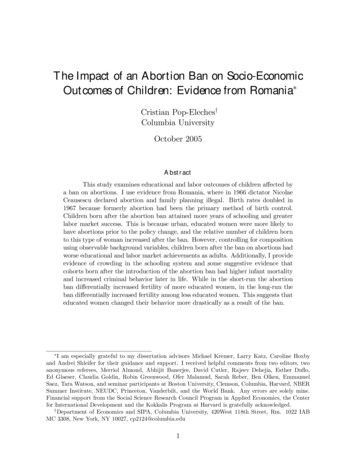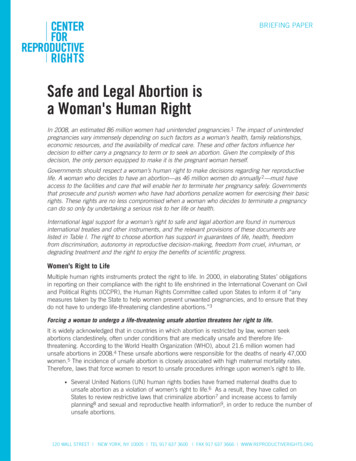
Transcription
BRIEFING PAPERSafe and Legal Abortion isa Woman's Human RightIn 2008, an estimated 86 million women had unintended pregnancies.1 The impact of unintendedpregnancies vary immensely depending on such factors as a woman’s health, family relationships,economic resources, and the availability of medical care. These and other factors influence herdecision to either carry a pregnancy to term or to seek an abortion. Given the complexity of thisdecision, the only person equipped to make it is the pregnant woman herself.Governments should respect a woman’s human right to make decisions regarding her reproductivelife. A woman who decides to have an abortion—as 46 million women do annually 2 —must haveaccess to the facilities and care that will enable her to terminate her pregnancy safely. Governmentsthat prosecute and punish women who have had abortions penalize women for exercising their basicrights. These rights are no less compromised when a woman who decides to terminate a pregnancycan do so only by undertaking a serious risk to her life or health.International legal support for a woman’s right to safe and legal abortion are found in numerousinternational treaties and other instruments, and the relevant provisions of these documents arelisted in Table I. The right to choose abortion has support in guarantees of life, health, freedomfrom discrimination, autonomy in reproductive decision-making, freedom from cruel, inhuman, ordegrading treatment and the right to enjoy the benefits of scientific progress.Women’s Right to LifeMultiple human rights instruments protect the right to life. In 2000, in elaborating States’ obligationsin reporting on their compliance with the right to life enshrined in the International Covenant on Civiland Political Rights (ICCPR), the Human Rights Committee called upon States to inform it of “anymeasures taken by the State to help women prevent unwanted pregnancies, and to ensure that theydo not have to undergo life-threatening clandestine abortions.”3Forcing a woman to undergo a life-threatening unsafe abortion threatens her right to life.It is widely acknowledged that in countries in which abortion is restricted by law, women seekabortions clandestinely, often under conditions that are medically unsafe and therefore lifethreatening. According to the World Health Organization (WHO), about 21.6 million women hadunsafe abortions in 2008.4 These unsafe abortions were responsible for the deaths of nearly 47,000women.5 The incidence of unsafe abortion is closely associated with high maternal mortality rates.Therefore, laws that force women to resort to unsafe procedures infringe upon women’s right to life. Several United Nations (UN) human rights bodies have framed maternal deaths due tounsafe abortion as a violation of women’s right to life.6 As a result, they have called onStates to review restrictive laws that criminalize abortion7 and increase access to familyplanning8 and sexual and reproductive health information9, in order to reduce the number ofunsafe abortions.120 WALL STREET NEW YORK, NY 10005 TEL 917 637 3600 FAX 917 637 3666 WWW.REPRODUCTIVERIGHTS.ORG
October 2011 Safe and Legal Abortion is a Woman's Human Right While the phrase “right to life” has been associated with the campaigns of those whooppose abortion, it has not been interpreted in any international setting to requirerestrictions on abortion. Most recently, the European Court of Human Rights, in the caseVo v. France, ruled that “it is neither desirable, nor even possible as matters stand, toanswer in the abstract the question whether the unborn child is a person for the purpose ofArticle 2 of the Convention ” (providing that “[e]veryone’s right to life shall be protectedby law”).10 The court therefore refused to adopt a ruling that would have called intoquestion the validity of laws permitting abortion in 39 member states of the Council ofEurope.Women’s Right to HealthInternational law guarantees women the right to “the highest attainable standard of physical andmental health.”11 The right to health requires governments to provide health care and to worktoward creating conditions conducive to the enjoyment of good health.12 In 2000, the Committeeon Economic, Social and Cultural Rights recognized that the right to health includes “the right tocontrol one’s health and body, including sexual and reproductive freedom, and the right to be freefrom interference.”13 Furthermore, the right to health “requires the removal of all barriers interferingwith access to health services, education and information, including in the area of sexual andreproductive health.”14The Protocol to the African Charter on Human and Peoples’ Rights on the Rights of Women in Africa(Maputo Protocol) explicitly recognizes that the right to health includes access to safe and legalabortion, at a minimum, in certain circumstances. It requires States Parties to “ensure that the rightto health of women, including sexual and reproductive health is respected and promoted” by takingappropriate measures to authorize abortion “in cases of sexual assault, rape, incest, and wherethe continued pregnancy endangers the mental and physical health of the mother or the life of themother or the foetus.”15Safe abortion services protect women’s right to health.The right to health can be interpreted to require governments to take appropriate measures toensure that women have the necessary information and the ability to make crucial decisions abouttheir reproductive lives, such as determining whether or not to continue a pregnancy, and toguarantee that women are not exposed to the risks of unsafe abortion, which can have devastatingeffects on their health, leading to long-term disabilities, such as uterine perforation, chronic pelvicpain or pelvic inflammatory disease. Such measures include removing barriers that interfere withwomen’s access to health services, such as legal restrictions on abortion, and ensuring access tohigh-quality abortion information and services.2 Several UN human rights bodies have recognized the deleterious impact of restrictiveabortion laws on women’s health16 and have consistently raised general concerns aboutthe inaccessibility of safe abortion services.17 The Programme of Action adopted at the International Conference on Population andDevelopment (ICPD) in 1994 called upon governments to consider the consequences ofunsafe abortion on women’s health.18 It states that governments should “deal with thehealth impact of unsafe abortion as a major public health concern.”19 At the 1995 Fourth World Conference on Women, the international community reiteratedthis language and urged governments to “consider reviewing laws containing punitivemeasures against women who have undergone illegal abortions.”20 In addition, in aCENTER FOR REPRODUCTIVE RIGHTS WWW.REPRODUCTIVERIGHTS.ORG
paragraph addressing research on women’s health, the Platform for Action adopted at thisconference urges governments “to understand and better address the determinants andconsequences of unsafe abortion.”21 In 1999, at the five-year review of the ICPD, governments recognized the need for greatersafety and availability of abortion services. They affirmed that “in circumstances where abortionis not against the law, health systems should train and equip health-service providers andshould take other measures to ensure that such abortion is safe and accessible. Additionalmeasures should be taken to safeguard women’s health.”22Women’s Right to Equality and Non-DiscriminationThe right to gender equality is a fundamental principle of human rights law. All major human rightsinstruments require freedom from discrimination in the enjoyment of protected human rights. Accordingto the Convention on the Elimination of All Forms of Discrimination against Women, “discriminationagainst women” includes laws that have either the “effect” or the “purpose” of preventing a womanfrom exercising any of her human rights or fundamental freedoms on a basis of equality with men.23In 1999, the Committee on the Elimination of Discrimination against Women (CEDAW Committee)recognized “laws that criminalize medical procedures only needed by women and that punish womenwho undergo those procedures” as a barrier to women’s access to appropriate health care. 24Denying women access to abortion is a form of gender discrimination.Laws that restrict abortion have the effect and purpose of preventing a woman from exercising any ofher human rights or fundamental freedoms on a basis of equality with men. Restricting abortion has the effect of denying women access to a procedure that may benecessary for their equal enjoyment of the right to health. Only women must live with thephysical consequences of unwanted pregnancy. Some women suffer maternity-related injuries,such as hemorrhage or obstructed labor. Women are consequently exposed to health risks notexperienced by men. Laws that deny access to abortion, whatever their stated objectives, have the discriminatorypurpose of both denigrating and undermining women’s capacity to make responsible decisionsabout their bodies and their lives. Indeed, it is not surprising that unwillingness to allow womento make decisions about their own bodies often coincides with the tendency to deny womendecision-making roles in the areas of political, economic, social, and cultural affairs. The CEDAW Committee has consistently expressed concern about restrictive laws thatcriminalize abortion.25 Furthermore, the Human Rights Committee has recognized thatcriminalizing abortion, even in cases of rape, is incompatible with the States’ obligation toensure the equal right of men and women to the civil and political rights set forth in theICCPR.26 Additionally, it has indicated that the problem of maternal mortality due to unsafeabortion is evidence of discrimination against women.27Women’s Right to Reproductive Self-DeterminationHuman rights instruments provide the basis for the right of women to make decisions regarding theirown bodies. In particular, they require the right to freedom in decision-making about private matters.Such provisions include protections of the right to physical integrity, the right to decide freely andresponsibly the number and spacing of one’s children and the right to privacy.3
October 2011 Safe and Legal Abortion is a Woman's Human RightWomen have the right to decide whether or not to bring a pregnancy to term.When a pregnancy is unwanted, its continuation can take a heavy toll on a woman’s physicaland emotional well-being. Decisions one makes about one’s body, particularly one’s reproductivecapacity, lie squarely in the domain of private decision-making. A pregnant woman may seek advicefrom others, but only she knows whether she is ready to have a child, and governments should playno role in making that decision for her. The Human Rights Committee has recognized that denying women access to legal abortionservices is an arbitrary interference in their private lives.28 The European Court of Human Rights has underscored the connection between pregnancyand a woman’s private life, which includes her physical and psychological integrity. It hasrecognized that States have a positive obligation to effectively secure the physical integrityof pregnant women.29 This obligation requires them to establish procedural safeguards toensure that women can make an informed decision about whether or not to terminate apregnancy30 and access safe and legal abortion services in a timely manner.31Woman’s Right to be Free from Cruel, Inhuman, or Degrading TreatmentInternational law recognizes that women have a right to be free from cruel, inhuman, or degradingtreatment. The Human Rights Committee has stated that cruel, inhuman, or degrading treatmentis not restricted to acts that cause physical pain, but also applies to mental suffering, which oftenaccompanies denials of access to abortion services.32Forcing women to carry pregnancies to term causes physical and mental suffering.As a result of restrictive abortion laws and policies, many women experiencing complications ofpregnancy and needing therapeutic abortion are forced to suffer from painful, frightening and lifethreatening conditions. Human rights bodies have recognized that restrictive abortion laws can lead to violations ofthe right to be free from cruel, inhuman and degrading treatment. The Committee againstTorture has recognized the impact of restrictive laws, which force women to carry unwantedpregnancies to term or to undergo illegal abortions that often place their health and lives indanger, and noted that the failure of States to take steps to prevent these acts constitutescruel and inhuman treatment.33 Specifically, it has indicated that a total prohibition onabortion, which forces a woman to carry a pregnancy resulting from a crime of genderbased violence, such as rape, “entails constant exposure to the violation committedagainst her and causes serious traumatic stress and a risk of long-lasting psychologicalproblems such as anxiety and depression.”34 The Human Rights Committee has statedthat criminalizing abortion is incompatible with the right to be free from cruel, inhuman ordegrading treatment.35Women may also undergo severe suffering and anguish when legal abortion services areinaccessible. 4In many countries, healthcare personnel refuse to provide legal abortion services becauseof their own objection or discriminatory attitudes towards abortions. In the case of L.M.R. v.Argentina, the Human Rights Committee found that the State’s failure to ensure a woman’saccess to abortion services to which she was legally entitled, caused her physical andmental suffering, which constituted cruel, inhuman or degrading treatment.36CENTER FOR REPRODUCTIVE RIGHTS WWW.REPRODUCTIVERIGHTS.ORG
Additionally, in the case of R.R. v. Poland, the European Court of Human Rights establisheda violation of the right to be free from inhumane and degrading treatment because of thesuffering experienced by R.R., due to the knowledge that she could not terminate herpregnancy even though the fetus had an incurable deformity and she was entitled to have anabortion under the Polish law.37 The Court stated that “[s]he suffered acute anguish throughhaving to think about how she and her family would be able to ensure the child’s welfare,happiness and appropriate long-term medical care.”38Furthermore, the denial of access to abortion services in certain circumstances, regardless of the legalityof the procedure, constitutes cruel, inhuman or degrading treatment. In the landmark decision of K.L. v. Peru, the Human Rights Committee found that thedepression and emotional distress experienced by a 17-year old girl were foreseeableconsequences of the State’s failure to enable her to benefit from a therapeutic abortion, andconstituted a violation of her fundamental right to be free from cruel, inhuman, or degradingtreatment.39 Notably, this ruling did not depend on the legality of abortion.40Women’s Right to the Enjoyment of the Benefits of Scientific ProgressThe Universal Declaration of Human Rights41 and the International Covenant on Economic, Social andCultural Rights42 enshrine the right to enjoy the benefits of scientific progress.Women have the right to access the full range of abortion technologies.As the medical and scientific communities make advances in abortion technologies, this right entitleswomen to access the full range of technologies for the safest abortion care. The right to the benefits of scientific progress is particularly salient in the context of abortionbecause numerous safe, effective and low-cost health interventions, such as medical abortions,can substantially improve women’s access to safe abortion services, thereby reducing theincidence of unsafe abortion, and decreasing the attendant maternal morbidity and mortalityrates. Medical abortion is an alternative to surgical abortion that generally uses two medicinesto end a pregnancy. The most common regimen calls for an oral dose of Mifepristone,followed by a dose of Misoprostol up to 48 hours later. This regimen, which can be initiatedas soon as pregnancy is confirmed, is approximately 95% effective.43 In 2005, the WHOadded Mifepristone and Misoprostol to its Model List of Essential Medicines, a list intendedto guide governments in their prioritization of necessary drugs for budgetary allocations andprocurement in their national health systems.44 Permitting medical abortion can significantly improve women’s overall access to safe abortionbecause it can be provided in a broad range of settings, such as in practitioner’s offices, andcan be offered by non-physicians, which helps to expand the pool of providers available toperform safe abortions.45 Additionally, reducing reliance on physicians can reduce costs andhelp make abortion more available and accessible to women. By approving medical abortionprotocols, training providers and removing barriers to the regimen, governments can ensurethat women have access to medical abortion in a safe setting, which allows them to enjoy theirright to the benefits of scientific progress.5
TABLE IHumanRightsProtectedInternational Legal InstrumentsUniversalDeclaration ofHumanRights46Civil andPoliticalRights47CovenantThe rightto life,liberty &securityArt. 3The rightto be freefrom cruel,inhumanor degradingtreatmentArt. 5The rightto equality& to befree fromgenderdiscriminationArt. l54EuropeanConventiononHumanRights55Art. 6.1Art. 6Art. 10Art. 4.1Art. 4Art. 4Art. 9.1Art. 37(b)Art. 14Art. 7.1Art. 6Cairo57Beijing58Art. 2.1Prin. 1Para. 106Art. 5.1Para.Para. 216Art. 37(d)Art. 7Art. 37(a)Art. 15Art. 5.2Art. 5Art. 4Art. 36Para. 56Para.4.10Art. 2.1Art. 2.2Art. 1Art. 3Art. 3Art. 2Art. 3(g)Art. 3Art. 5Art. 2Art. 3(b)Art. 1Art. 2Art. 2Art. 2Art. 14Para. 18Prin. 1Para. 214Prin. 4Para. 216Art. 3Art. 6Para. 232Art. 18.3Art. 24.3Art. 3Art.Para. 18Para.Para. 1072(2)Para. 384.4Para. 224Para. 49Para.Para. 230Art. 55.5Para.9.2Art. 25Art. 12ArtArt. 24Art. 25Art. 16Art. 14Para. 1811.1(f)Para. 24Art. 11.3Para. 31Art. 12Para. 41Art.Art. 12Art. 17Art. 16Art. 3(a)Art. 11Art. 8Art. 22Theright todeterminenumber& spacingof one'schildrenThe rightto theenjoymentof thebenefits ofscientificprogressVienna568.3414.2(b)The rightto privacyConference DocumentsArt. 37(c)The rightto modifycustomsthatdiscriminateagainstwomenThe rightto health,reproductive health,& familyplanningWomen’sConvention49Regional Legal InstrumentsArt. 27Art.Art.16.1(e)23(b)Art.14(1)(b)Prin. 8Para.7.2Para.7.3Para.7.5Para. 89Para.Para. 1067.2Para. 107Prin. 8Para. 223Para.7.3Art.Para.15(b)7.3CENTER FOR REPRODUCTIVE RIGHTS WWW.REPRODUCTIVERIGHTS.ORGPara. 92Para. 106Para. 223
Endnotes12345678910111213Susheela Singh et al., Unintended Pregnancy: WorldwideLevels, Trends, and Outcomes, 41 Studies in Family Planning241, 243 (2010). Unintended pregnancies are comprised of“unplanned births, induced abortion, and miscarriages.” Id. at241.World Health Organization (WHO), Safe Abortion:Technical and Policy Guidance for Health Systems 12(2003).Human Rights Committee, General Comment No. 28: Equalityof rights between men and women (Art. 3) (68th Sess., 2000),para. 10, U.N. Doc. CCPR/C/21/Rev.1/Add.10 (2000).World Health Organization (WHO), Unsafe Abortion:Global and regional estimates of the incidence of unsafeabortion and associated mortality in 2008 1 (6th ed.2011).Id. at 27.See, e.g., Rep. of the Comm. on the Elimination ofDiscrimination against Women (CEDAW Committee), 20thSess., Jan. 19 – Feb. 5, 1999, 21st Sess., June 7-25, 1999, pt.2, ch. IV, Belize, para. 56, U.N. Doc. A/54/38/Rev. 1, GAOR,54th Sess., Supp. No. 38 (1999) [hereinafter CEDAW 1999];CEDAW 1999, pt. 1, ch. IV, Colombia, para. 393; Rep. ofthe CEDAW Committee, 18th Sess., Jan 19 – Feb. 6, 1998,19th Sess., June 22 – July 10, 1998, pt. 1, ch. IV, DominicanRepublic, para. 337, U.N. Doc. A/53/38/Rev. 1, GAOR, 53rdSess., Supp. No. 38 (1998) [hereinafter CEDAW 1998]; Rep.of the Human Rights Committee, 76th Sess., Oct. 14 – Nov. 1,2002, 77th Sess., Mar. 17 – Apr. 4, 2003, 78th Sess., 78th Sess.,July 13 – Aug. 8, 2003, para. 81(14), U.N. Doc. A/58/40 (Vol.I), GAOR, 58th Sess., Supp. No. 40 (2003).See, e.g., CEDAW 1999, supra note 6, pt. 2, ch. IV, Chile,para. 229; CEDAW 1998, supra note 6, at pt. 2, ch. IV, Peru,para. 340; CEDAW Committee, Concluding Observations:Philippines, para. 28, U.N. Doc. CEDAW/C/PHI/CO/6 (2006);Human Rights Committee, Concluding Observations: Poland,para. 8, U.N. DOC. CCPR/CO/82/POL (2004).See, e.g., Rep. of the CEDAW Committee, 32nd Sess., Jan10-28, 2005, 33rd Sess., July 5-22, 2005, pt. 2, ch. 4, BurkinaFaso, para. 350, U.N. Doc. A/60/38, GAOR, 60th Sess., Supp.No. 38 (2005); Rep. of the CEDAW Committee, 26th Sess.,Jan. 14 – Feb. 1, 2002, 27th Sess., June 3-21, 2002, ExceptionalSess., Aug. 5-23, 2002, pt. 3, ch. 4, Czech Republic, para. 102,U.N. Doc. A/57/38, GAOR, 57th Sess., Supp. No. 38 (2002);CEDAW Committee, Concluding Observations: Mali, para. 34,U.N. Doc. CEDAW/C/MLI/CO/5 (2006); CEDAWCommittee, Concluding Observations: Nicaragua, para. 18,U.N. Doc. CEDAW/C/NIC/CO/6 (2007).See, e.g., CEDAW Committee, Concluding Observations:Bosnia and Herzegovina, para. 36, U.N. Doc. CEDAW/C/BIH/CO/3 (2006); CEDAW Committee, Concluding Observations:Cape Verde, para. 30, U.N. Doc. CEDAW/C/CPV/CO/6 (2006);CEDAW Committee, Concluding Observations: Namibia, para.25, U.N. Doc. CEDAW/C/NAM/CO/3 (2007).Vo v. France, 53924/00, Eur. Ct. H.R., para. 85 (2004).International Covenant on Economic, Social and CulturalRights, adopted Dec. 16, 1966, art. 12 G.A. Res. 2200A (XXI),U.N. GAOR, Supp. No. 16, U.N. Doc. A/6316 (1966) (enteredinto force Jan. 3, 1976), [hereinafter ICESCR].Anika Rahman & Rachel Pine, An International Human Rightto Reproductive Health Care, 1 Health and Human Rights405, 406 (1995); Brigitte Toebes, The Right to Health as aHuman Right in International Law 245-258 (1999).Committee on Economic, Social and Cultural Rights, GeneralComment No. 14: The right to the highest attainable standard ofhealth, (22nd Sess., 2000), para. 80, U.N. Doc. E/C.12/2000/4(2000).14 Id., para. 21.15 Protocol to the African Charter on Human and Peoples’Rights on the Rights of Women in Africa, 2nd OrdinarySess., Assembly of the Union, adopted July 11, 2003, art. 14[hereinafter Maputo Protocol].16 See, e.g., Human Rights Committee, Concluding Observations:Argentina, para. 14, U.N. Doc. CCPR/CO/70/ARG (2000);CEDAW 1999, supra note 6, pt. 2, ch. IV, Chile, para. 228;CEDAW 1999, supra note 6, pt. 1, ch. IV, Colombia, para. 393.17 See, e.g., Human Rights Committee, Concluding Observations:Mali, para 14., U.N. Doc. CCPR/CO/77/MLI (2003); HumanRights Committee, Concluding Observations: Poland, para.11, U.N. Doc. CCPR/C/79/Add.110 (1999); CAT Committee,Concluding Observations: Chile, para. 7(m), U.N. Doc. CAT/CR/32/5 (2004).18 Programme of Action of the International Conference onPopulation and Development, Cairo, Egypt, 5-13 September1994, para. 8.25, U.N. Doc.A/CONF.171/13/Rev.1 (1995)[hereinafter ICPD Programme of Action].19 Id.20 The Beijing Declaration and The Platform for Action, FourthWorld Conference on Women, Beijing, China, Sept. 4-15, 1995,para. 106K, U.N. Doc. A/CONF.177/20 (1996) [hereinafterBeijing Declaration and Platform for Action].21 Id.,para 109(I).22 Key Actions for Further Implementation of the Program ofAction of the International Conference on Population andDevelopment, para. 63iii, U.N. GAOR, 21st Special Sess., June30-July 3, 1999, U.N. Doc. A/S-21/5/Add.1 (1999).23 Convention on the Elimination of All Forms of Discriminationagainst Women, adopted Dec. 18, 1979, art. 1, G.A. Res.34/180, U.N. GAOR, 34th Sess., Supp. No. 46, at 193,U.N. Doc. A/34/46 (1979) (entered into force Sept. 3, 1981)[hereinafter CEDAW].24 Committee on the Elimination of Discrimination againstWomen, General Recommendation No. 24: Article 12of the Convention (women and health), (20th Sess.,1999), in Compilation of General Comments and GeneralRecommendations Adopted by Human Rights Treaty Bodies, at358, U.N. Doc. HRI/GEN/1/Rev.9 (Vol. II) (2008).25 CEDAW Committee, Concluding Observations: Pakistan, para.40, U.N. Doc. CEDAW/C/PAK/CO/3 (2007), para. 40; CEDAWCommittee, Concluding Observations: Chile, para. 19, U.N.Doc. CEDAW/C/CHI/CO/4 (2006).26 Human Rights Committee, Concluding Observations, Peru,para. 20, U.N. Doc. CCPR/CO/70/PE (2000) [hereinafterHuman Rights Committee, Concluding Observations: Peru].27 Human Rights Committee, Concluding Observations,Mongolia, para. 8(c), U.N. Doc. CCPR/C/79/Add.120 (2000).28 K.L. v. Peru, Human Rights Committee, Communication No.1153/2003, para. 6.4, U.N. Doc. CCPR/C/85/D/1153/2003(2005).29 Tysiąc v. Poland, 5410/03, Eur. Ct. H.R., para. 107 (2007).30 R. R. v. Poland, 27617/04, Eur. Ct. H.R., para. 209 (2011).31 Id., para. 203; Tysiąc v. Poland, para. 127-30.32 Human Rights Committee, General Comment No. 20: Replacesgeneral comment 7 concerning prohibition of torture and crueltreatment or punishment (Art. 7), (44th Sess., 1992), ch. II, para.5 at 200, U.N. Doc. HRI/GEN/1/Rev.9 (Vol. I) (2008).33 CAT Committee, Concluding Observations: Peru, para. 23,U.N. Doc. CAT/C/PER/CO/4 (2006).34 CAT Committee, Concluding Observations: Nicaragua, para.16, U.N. Doc. CAT/C/NIC/CO/1 (2009).35 Human Rights Committee, Concluding Observations: Peru,supra note 26, para. 20.7
October 2011 Safe and Legal Abortion is a Woman's Human Right36 L.M.R. v. Argentina, Human Rights Committee, Views:Communication No. 1608/2007, para. 9.2, U.N. Doc.CCPR/C/101/D/1608/2007 (2011).37 R. R. v. Poland.38 R. R. v. Poland, para. 159.39 K.L. v. Peru, para. 6.3.40 Id.; Christina Zampas & Jamie Gher, Abortion as a HumanRight: International and Regional Standards, 8 HumanRights Law Review 249, 270 (2008).41 Universal Declaration of Human Rights, adopted Dec. 10,1948, art. 27, G.A. Res. 217A (III), U.N. Doc. A/810 at 71(1948) [hereinafter Universal Declaration].42 ICESCR, supra note 11, art. 15(b).43 Mifepristone is a drug that blocks progesterone receptorsand thereby detaches the embryo from the uterus.Misoprostol is a prostaglandin analog that causesuterine contractions in order to complete the abortion.Mifepristone, which was first approved for medicalabortion in France in 1988, is also commonly known byits original French name, RU-486. Dr. Paul BlumenthalEt Al., Providing Medical Abortion in Low-ResourceSettings: An Introductory Guidebook 1, 3, 11, 13(Katrina Abuabara et al. eds., 2nd ed. 2004) [hereinafterProviding Medical Abortion]; Ipas, Medical Abortion –Implications for Africa 4 (2003).44 WHO, Essential Medicines: WHO Model List (revisedMarch 2005) 20 (14th ed., 2005).45 Providing Medical Abortion supra note 43, at 32; BonnieScott Jones & Simon Heller, Providing Medical Abortion:Legal Issues of Relevance to Providers, 55 Journal of theAmerican Medical Women’s Association 145 (2000).46 Universal Declaration, supra note 41.47 International Covenant on Civil and Political Rights, G.A.Res. 2200A (XXI), U.N. GAOR, 21st Sess., Supp. No. 16,U.N. Doc A/6316 (1966), 999 U.N.T.S. 171 (entered intoforce Mar. 23, 1976).48 ICESCR, supra note 11.49 CEDAW, supra note 23.50 Convention on the Rights of the Child, adopted Nov. 20,1989, G.A. Res. 44/25, annex, U.N. GAOR, 44th Sess.,Supp. No. 49, at 166, UN Doc. A/44/49 (1989), reprintedin 28 I.L.M. 1448 (entered into force Sept. 2, 1990).51 Convention on the Rights of Persons with Disabilities,adopted Dec. 13, 2006, art, XX, para. XX, G.A. Res. A/RES/61/106, UN GAOR, 61st Sess., U.N. Doc. A/61/611,(entered into force May 3, 2008).52 American Convention on Human Rights, Nov. 22, 1969,O.A.S.T.S. No. 36, O.A.S. Off. Rec. OEA/Ser.L/V/II.23,doc. 21, rev. 6 (entered into force July 18, 1978).53 African Charter on Human and Peoples’ Rights, adoptedJune 27, 1981, O.A.U. Doc. CAB/LEG/67/3, rev. 5, 21I.L.M.58 (1982) (entered into force Oct. 21, 1986).54 Maputo Protocol, supra note 15.55 Convention for the Protection of Human Rights andFundamental Freedoms, adopted Nov. 4, 1950, 213U.N.T.S. 222, Eur. T.S. No. 5 (entered into force Sept. 3,1953).56 Vienna Declaration and Programme of Action, WorldConference on Human Rights, Vienna, Austria, June 14-25,1993, U.N. Doc. A/CONF.157/23 (1993).857 ICPD Programme of Action, supra note 18.58 Beijing Declaration and Platform for Action, supra note20.CENTER FOR REPRODUCTIVE RIGHTS WWW.REPRODUCTIVERIGHTS.ORG
The right to gender equality is a fundamental principle of human rights law. All major human rights instruments require freedom from discrimination in the enjoyment of protected human rights. According to the Convention on the Elimination of All Forms of Discrimination against Women, "discrimination
